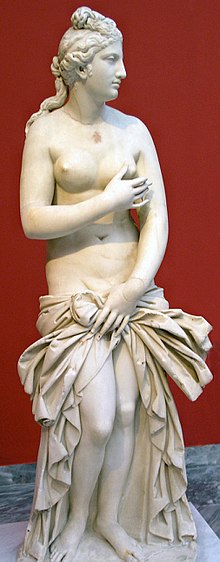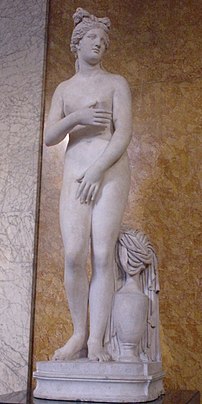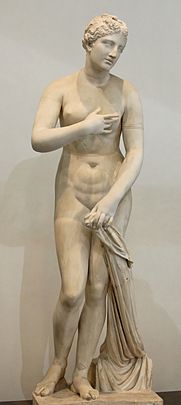Capitoline Venus

The Capitoline Venus is a type of statue of
This original of this type (from which the following copies derive) is thought to be a lost 3rd- or 2nd-century BCE variation on Praxiteles' work from
Principal example
The Capitoline Venus is a slightly over lifesize
It was found on the
The statue was on loan to the United States and was shown in the rotunda of the West Building of the National Gallery of Art in Washington, D.C. from June 8 to September 18, 2011.[4]
Its reputation vis-a-vis the Venus de' Medici in Florence grew only slowly, according to Haskell and Penny, fueled in part as a negative sensitivity to extensive restorations began to undermine the Florentine Venus. It was triumphantly removed to Paris by Napoleon under the terms of the Treaty of Tolentino; the Emperor commissioned a marble replica from Joseph Chinard, now at the Château de Compiègne. When the original was returned to the Capitoline Museums in 1816,[5] the plaster cast that had replaced it during the Napoleonic era was shipped to Britain, where John Flaxman praised it to his students (Haskell and Penny 1981:319).
-
Campo Iemini Venus (British Museum)
-
Aphrodite of Menophantos (Museo Nazionale Romano)
Other copies
| External videos | |
|---|---|
 | |

About 50 copies of Venus Pudica are extant, with most of them displayed in Europe.[6]
- The Chigi. Johann Joachim Winckelmann described this sculpture in his Geschichte der Kunst des Altertums (vol V, ch. II).[10]
- The William IVdonated it to the British Museum.
- A 2nd-century Roman copy of Parian marble was found at Baiae.
- A version of Venus Pudica was also found in Hadrian Baths at Nazi-leader Hermann Göring. The statue graced the bedroom of his country estate near Berlin, Carinhall. It was returned to Libya in 1999. and today, it is in the National Archaeological Museum in Tripoli.
- Another armless copy of Capitoline Venus, kept at Jamahiriya Museum, Tripoli, Libya.
- One variant is kept at the Hermitage Museum, St. Petersburg,[11] as well as the similar Venus Tauride.[12][13]
- The Venus Landolina at the Syracuse Archeological Museum in Sicily. It is a headless Imperial Roman copy of a 2nd-century, similar to the Aphrodite of Syracuse kept in Athens.
- A 3rd century copy was found during archaeological excavations at Skupi, an ancient Roman town in North Macedonia.
- A 2nd to 3rd century Italian marble copy of Capitoline Venus is the result of connecting the lower part of an ancient body, a torso from the 16th century and an ancient face and the top of head. It was previously in the Borghese collection, and now kept at Louvre Museum, Paris. Inv No. MR. 279 (Usual No Ma 369).
- A copy of Capitoline Venus is held at Galleria degli Uffizi. It entered the Medici collections after a purchase from the Colonna family. The statue lacked arms, head and right leg. The Medici had it integrated by sculptor Silla in 1584 and the statue thus acquired its present aspect as a faithful reproduction of the Capitoline Venus.
- A 2nd century copy of Capitoline Venus is held by the National Museum in Warsaw.
- A headless statue of Capitoline Venus made in the 2nd-3rd century is held at the Naples Archaeological Museum.
- A headless painted Roman period marble copy of Capitoline Venus of the 2nd century from Aphrodias, Asia Minor, was excavated by the Hebrew University of Jerusalem (H: 159 cm; W: 60 cm).
- A damaged ancient copy of Capitoline Venus is kept at Antalya Archaeological Museum.
- A torso from white marble, 2nd century, unknown provenance at Museo Nazionale Romano: Terme di Diocleziano, inv. 2000656, Rome, Italy.
- TA head from white marble, dated to the last quarter of the 1st century BCE — beginning of the 1st century CE, at Cremona, San Lorenzo Archaeological Museum. Origin: Cremona, p-zza Marconi.
- A Roman period marble torso, similar to the Aphrodite Syracuse, held at the Cyprus Museum.
Notes
- ^ 1.93 m (6 ft. 3 ¾ in.).
- ^ According to the memoirs of the antiquarian Pietro Santi Bartoli noted in Haskell and Penny 1981:318).
- ^ Accession number MC 0409
- ^ "National Gallery of Art. "A Masterpiece from the Capitoline Museum, Rome: The Capitoline Venus"". Archived from the original on 2011-06-11. Retrieved 2011-06-22.
- ISBN 978-1-134-26854-2.
- ^ a b "Capitoline Venus". Smarthistory at Khan Academy. Retrieved April 9, 2016.
- Thomas Hope (1769–1831), whose heirs sold it in 1917; Hope's Venus is conserved at the Leeds Art Gallery(Hugh Honour, "Canova's Statues of Venus", The Burlington Magazine, 114 No. 835 (October 1972), pp. 658-671, esp. p. 667).
- ^ "Apo tis en troadi afroditis minofantos epoiei"
- ^ Christian Hülsen, Le Chiese di Roma nel Medio Evo: S. Gregorii in Clivo Scauri
- ^ William Smith, A Dictionary of Greek and Roman Biography and Mythology Archived 2008-05-06 at the Wayback Machine, (1870) vol. II.1044.
- ^ Atsma, Aaron.Of Type Capitoline Venus Theoi Project. Retrieved on May 13, 2008.
- ^ Atsma, Aaron. "Tauride Venus". Theoi Project. Retrieved on May 13, 2008.
- ^ "Aphrodite: Tauride Venus". State Hermitage Museum. Retrieved on July 5, 2022.
References
- Haskell, Francis and Nicholas Penny, 1981. Taste and the Antique: The Lure of Classical Sculpture 1500-1900. Yale University Press. Cat. no. 84.
- Helbig, Wolfgang. Führer durch die öffentlichen Sammlungen klassischer Altertümer in Rome. 4th edition, 1963–72, vol. II.
- Wilton, A. and I. Bignamini (editors.). Grand Tour: the lure of Italy in the eighteenth century London, Tate Gallery Publishing, 1996. no. 228, pp. 269–270. (the Campo Iemini Venus).
External links
- British Museum: Campo Iemini Venus Archived 2015-10-25 at the Wayback Machine
- "Aphrodite of Menophantus"


